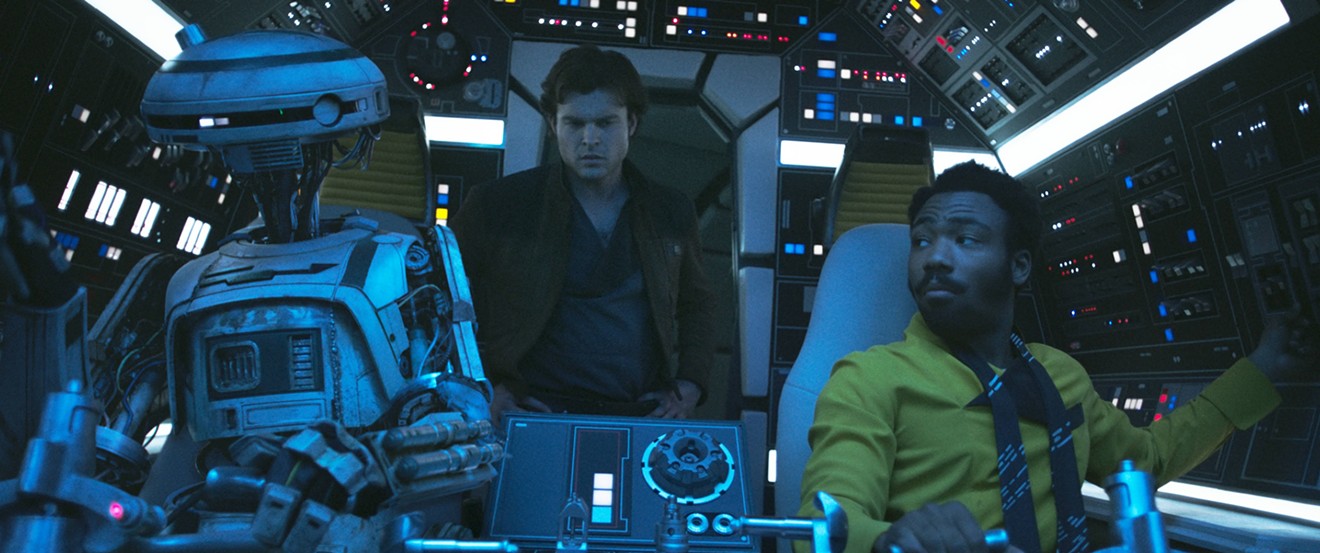One peak of Star Wars – and all fantasy-adventure filmmaking – comes about an hour into Irvin Kershner’s The Empire Strikes Back (1980), when Harrison Ford’s Han Solo pilots his Millennium Falcon through a blockade of Imperial Star Destroyers, those great silver-gray doorstop-ships each the size of a city. As the inevitable TIE Fighters screech in pursuit, copilot Chewbacca worries over deflector shields and prepares to make the jump to lightspeed and Solo corkscrews the Falcon through space, baffling his enemies’ targeting.
In the original Star Wars, the spaceships zipped along but seemed locked into set, stiff trajectories; now, thanks to breakthroughs in effect technology, the Falcon seems to dance. It twirls and weaves, its dizzy grace in hilarious contrast to the scene inside it. That prim motormouth C-3PO has finally managed to tell Solo the terrible truth: The Falcon can’t jump to lightspeed and escape this fight. So, Solo, exhibiting the slightly disquieted cocksureness that made Ford one of his generation’s greatest movie stars, dares the most foolhardy of maneuvers. He flies into an asteroid belt, barking at that droid, “Never tell me the odds!”
It might seem unfair to compare Ron Howard’s prequel Solo: A Star Wars Story to Empire’s asteroid set piece, a sequence that balances — through its shrewd scripting, sharp editing, urgent pulp acting and still-dazzling effects work — all the tension, humor and wonder so often missing from the movie adventure fantasies that careen at us all year long like space rocks at those TIE Fighters. Yet Solo demands the comparison by essentially restaging the 1980 scene, right down to borrowing John Williams’ Empire asteroids score. This time, though, when Solo zips his Falcon into a bad-news patch of space, the tension is diffused, the stakes unclear, specifics vague. Empire showed us a ballet of rocks and ships but never more than the eye could track. It’s clear in each shot where the Falcon is in relation to the Imperials, and where the asteroids are in relation to them and what kind of brash maneuvering Solo must make at each breath.
In Solo, on the other hand, the cockpit shots and the effects shots seem only vaguely related to each other. What exactly the Falcon is flying into — space gasses and shards of planet — is unclear. We don’t get many Empire-style master shots, so you can’t tell how the chase is going. The film’s attentions are further divided than they were in Empire. Solo keeps cutting from the cockpit, where we should be witnessing the birth of Han Solo’s steeliness, to his salty heist-leader mentor (Woody Harrelson) down below, firing at the TIE Fighters. Those ships dutifully explode once in a while, though why they do when they do seems determined by the rhythm of the sequence rather than the logic of the narrative. When we finally see the Falcon itself, surging through a psychedelic miasma that simply overwhelms the eye, the maneuverings of the ship and the physical performance of the actor playing its pilot have no clear connection. Solo’s actions in that Empire chase revealed Solo to us, his brashness and his doubts, his quick thinking and reflexes, his inspired opportunism. Solo’s actions here reveal only the miraculousness of Empire.
As for the rest of the movie? Let’s start here: In the first season of The Good Place, Ted Danson’s avuncular godlike character announces, “I've come to really like frozen yogurt. There's something so human about taking something great and ruining it a little so you can have more of it.” It’s no slight to Alden Ehrenreich to note that his performance as Han Solo is froyo Harrison Ford’s ice cream. Anybody’s would be. Even Ford couldn’t ace it every time, and went all yogurt-y himself in Return of the Jedi. Apparently, one side effect of the carbon freezing Han suffered in Empire is that you emerge looking really bored. Ehrenreich wisely goes for Ford’s essence rather than a direct imitation, and he and the filmmakers play up a boyish naivete, the idea being that the adventure we’re watching is what made the kid Han. His hardening into Hanhood is literalized here by the design of the Falcon. In Solo, the galaxy’s most beloved hunk of junk is new and sleek, its familiar gap-toothed front end filed in and rounded off. Yes, this is a movie in which the young rogue literally notches his spaceship.
Like Rogue One, the other standalone Disney Star Wars film that suffered a famously troubled production, Solo has a just-finish-the-movie quality to it, an uncertainty about the pacing and seriousness of developments in its own story. An early, exhausting heist sequence includes moments of tragedy that get followed too soon by more high adventure and never seem to weigh on the other characters. The look is murky, its compositions undistinguished, especially in comparison to the ravishments of Rian Johnson’s The Last Jedi. Early scenes set in the factory hellscape of the planet Corellia get swathed in a heavy blue tint that obscures the characters as much as a blanket might have. Why commit to creating elaborate monster puppets if we can’t even see them? And the scenes of action, for the most part, play something like they did in Howard’s 2013 Formula One movie Rush, where a yapping British sports announcer — shades of C-3PO! – had to explain to us every turn of the races.
Howard joined the production late, so, this isn’t just a Ron Howard Star Wars. It’s a rushed Ron Howard Star Wars. (I imagine him shouting “Never tell me the odds!” as he vaulted into his director’s chair.) Still, Howard stamps the material in some welcome ways: The scruffy breeziness of his early comedies (Night Shift, Splash, Gung Ho) suits the hit-and-miss script, by Lawrence and Jonathan Kasdan. Here’s a Star Wars that’s more appealing when its characters are chatting than when they’re pew-pewing. Howard, of course, acted in George Lucas’ American Graffiti and directed his own ’70s car-chase feature, 1977’s Grand Theft Auto. His intimate connection to the gearhead Modesto car culture that inspired Lucas to create Han Solo in the first place is apparent in the film’s simplest, most satisfying stretch of action, an early chase on clunky landspeeders through the streets of Corellia. He also seizes on the iconography of the Westerns that inspired Lucas, especially in the final scenes, which are among the film’s best. But too much of the film lacks the tactile specificity about vehicles and hardware of Howard’s car films or Apollo 13. The relationships between ships and pilots have none of the intimate immediacy of that between Grand Theft Auto’s cars and drivers.
This is the fourth Disney Star Wars feature, but only the second not to climax with an assault on or by a Death Star or its stand-in. The Kasdans, like Howard, instead reach back to the films that Lucas himself mined, which lifts Solo, at its best, out of the muck of franchise self-reference. The chief relationships are persuasively sketched, especially between Solo and his Wookiee (their meeting is a straight-up highlight) and Solo and his first love, Emilia Clarke’s (eventual) femme fatale Qi'ra. At worst, the Kasdans’ screenplay strains for comedy, casting new droid L3-37, voiced by Phoebe Waller-Bridge, as a crusader for the rights of droids across the galaxy, lamely muddying issues of sentience and slavery in Star Wars just for a couple of go-nowhere gags. The flesh characters sound right, including Donald Glover’s Lando Calrissian, but nothing in the storytelling is as smart as Glover. This all may take place a long time ago in a galaxy far, far away, but this Lando’s card-up-the-sleeve horny-coward act was stale in our universe well before Billy Dee Williams first got cast in the role. Inexcusably, to let Han outfox his rival, the script demands Lando be dumb. Solo, like the Falcon in Empire, tends to sputter just when it should leap into hyperdrive.
[
{
"name": "Air - MediumRectangle - Inline Content - Mobile Display Size",
"component": "18855504",
"insertPoint": "2",
"requiredCountToDisplay": "2"
},{
"name": "Editor Picks",
"component": "17105533",
"insertPoint": "4",
"requiredCountToDisplay": "1"
},{
"name": "Inline Links",
"component": "18349797",
"insertPoint": "8th",
"startingPoint": 8,
"requiredCountToDisplay": "7",
"maxInsertions": 25
},{
"name": "Air - MediumRectangle - Combo - Inline Content",
"component": "17105532",
"insertPoint": "8th",
"startingPoint": 8,
"requiredCountToDisplay": "7",
"maxInsertions": 25
},{
"name": "Inline Links",
"component": "18349797",
"insertPoint": "8th",
"startingPoint": 12,
"requiredCountToDisplay": "11",
"maxInsertions": 25
},{
"name": "Air - Leaderboard Tower - Combo - Inline Content",
"component": "17105535",
"insertPoint": "8th",
"startingPoint": 12,
"requiredCountToDisplay": "11",
"maxInsertions": 25
}
]












